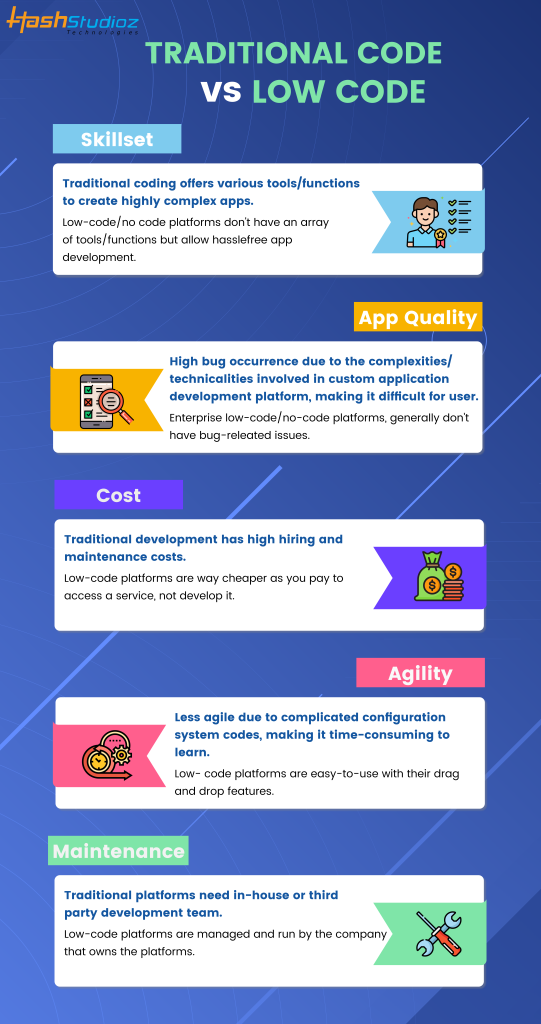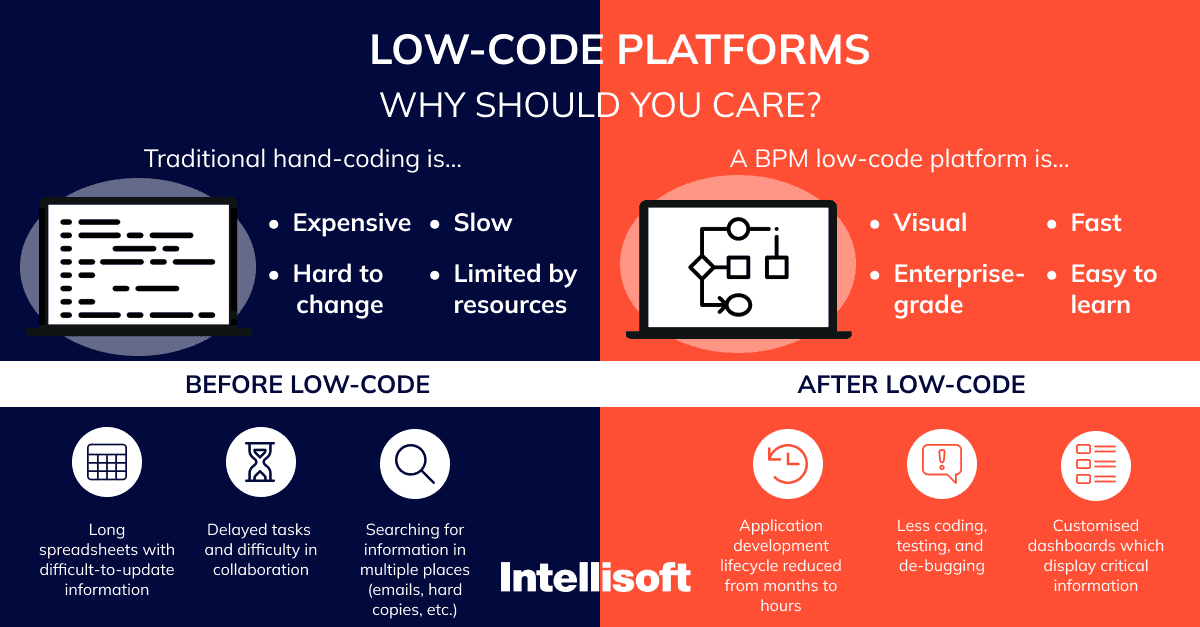Recommended Info To Selecting Low-Code Platform Info
Wiki Article
Benefits Of Low-Code Application Development Terms Of Speed
Visual Development Environment (VDE):
Drag-and-Drop Interfaces: Low-code platforms provide visual tools for designing applications. Developers can use drag-and-drop components to build applications quickly without having to write a lot of code.
A lot of low-code platforms come with already-built templates and parts. This lets developers quickly build or prototype applications, without having start with a blank slate.
Reduced Coding Requirements
Automated Code Generation: Low-code platforms automatically generate the code base on the visual models designed by programmers. This reduces need for manual code coding.
Reusable component: Developers may use the same components for various projects. This cuts down time spent on developing code and testing.
Collaboration can be made easier.
Integrated Development Tools: Low codes platforms usually have tools for testing as well as deployment, version control and. They facilitate collaboration among teams.
Citizen Development: Non-developers and business users can use simple interfaces to help in the creation of applications, which reduces bottlenecks caused due to a shortage of professionals to develop applications.
Rapid prototyping and rapid iteration
Fast Prototyping Developers can quickly build prototypes for ideas to be tested and feedback collected, resulting to faster iteration.
Easy Modifications: Low-code design is oriented towards visuals, which makes it much easier to modify and update applications. It helps speed up the process for developing and improving applications based on feedback from users.
Pre-built Integrations:
API Integrations. Many low-code platforms include connectors built for well-known APIs and services. This will make it easier to integrate systems.
Data Integration: The tools that are built into the software simplify and accelerate the process of connecting databases, data sources, and applications.
Deployment, scaling and deployment:
One-Click deployment: Many platforms that make use of low-code have an option to deploy applications, thus reducing the time and effort.
Cloud-Based Solution: Cloud based low code platforms are capable of handling infrastructure management and scaling. This allows developers to concentrate on functionalities, application logic and features instead of deployment logistics.
The overall efficiency of developing low-code applications lies in its ability to simplify and automate a number of aspects of the development process. This allows for faster development of apps and faster adaption to changes in requirements. View the top Low-code Platform for application development for website tips including application development platforms, ms azure sql, driver jdbc, software for app development, develop web application, azure sql server, application development platforms, push notifications android, build with docker, azure sql server and more.

Benefits Of Low-Code Application Development In Terms Of Scalability, And Flexible
Low-code application development has many advantages when it comes to the ability to scale and flexibility. These are crucial for building applications that can expand with the needs of businesses and adapt to changing requirements. Here are some of the key benefits.
Cloud-based Deployment : Many low-code platforms are built. This allows applications to expand seamlessly with cloud infrastructure. Businesses can manage increased workloads without having to worry about server management.
Auto-Scaling Functions: Auto scaling functions can be used to adjust resources automatically in response to demand. They ensure that the performance remains consistent even in peak hours.
Flexible Architecture:
Modular design Low-code platforms are a great way to promote modular software. These allow components to be developed independently as well as tested, sized, etc. This modularity improves flexibility and facilitates upgrades or expansions of certain components without affecting the overall system.
Microservices Integration Support for microservices architecture allows applications to be developed as a collection of loosely coupled services, enhancing both scalability and flexibility.
Customizable Solution:
Extensibility Low-code platforms usually permit custom programming and scripting. Developers can enhance the capabilities of their applications beyond what is available out of the box. This allows companies to meet their own unique requirements.
Third-Party Integrations: The capacity to connect with third-party services and APIs enables companies to add additional functions and services, enhancing the application's capabilities.
Agile Development Deployment, Agile Development and Agile Development:
Continuous Delivery and Deployment: Low-code platform support agile methodologies that allow continuous integration and continuous delivery (CI/CD). This facilitates rapid deployment of new features and updates. Applications can then grow rapidly in response to market developments and user feedback.
Iterative Design: Since low-code is an iterative procedure, applications can be incrementally enhanced and scaled up. This permits controlled growth, and minimizes the risk of large-scale modifications.
Resource Optimization
Efficient Resource management: Low-code platform tools assist in optimizing the use of resources by monitoring and regulating the performance of software. It ensures that resources are utilized efficiently, and can be increased or decreased according to the actual needs.
Load Balancing : The integrated load balancing function distributes workloads evenly among servers. This enhances the application's ability to handle large volumes of traffic, and ensures the same performance.
Global Reach
Multi-Region deployment: Low-code platforms typically allow deployment across different geographical regions. This allows companies to offer low-latency to users across the globe. This is particularly important for applications with an international user base.
Localization: Support for localization is integrated into the software, allowing applications to be easily modified to accommodate various languages or regional needs. This allows for greater flexibility in different markets.
Maintenance and updates:
Simple Maintenance : Low-code applications are modular and visual. This makes maintenance easier. This allows bugs and updates to be made quickly, with no extensive downtime.
Version Control: Integrated version control systems manage changes and rollbacks to ensure that updates can safely be made and that older versions are restored when needed.
Cost Efficiency:
Low Development Costs: By decreasing the amount of programming required, low code platforms can lower the development cost. This allows to expand applications without having to increase development efforts and expenses.
Pay-Asyou-Go Models Many low code platforms have flexible pricing options for their services, including the pay-as-you go model, which aligns costs with actual usage and growth. This allows flexibility in the financial plan.
Low-code development gives businesses a number of advantages, such as scalability, flexibility and ad-hoc adaptability. This enables them to develop robust, flexible and scalable applications. These platforms allow quick adjustments to evolving requirements, efficient resource usage, and continual enhancement. This ensures that applications can evolve with the needs of the business. Follow the best Enterprise application development with Low-code Platform url for more tips including application modernization software, develop web app, stored sql procedures, cloud software applications, stored sql procedures, cross platform app dev, application modernization, push notifications, paas service, database in azure and more.

Benefits Of Low-Code Application Development In Terms Of Collaboration And Workflow
Low-code development can offer many benefits in collaboration and workflow. This makes it a great solution for businesses looking to increase productivity and speed up the development process. These are the primary advantages.
Unified Development Environment : Low-code platforms provide a single, unified environment in which all team members can collaborate efficiently including business analysts, designers and others. This reduces silos and promotes greater communication.
Visual Development Tools Low-code platforms are straightforward to use, and come with an interface that allows drag-and-drop. This lets non-technical people on the team to take part in the process of development and ensures that the business requirements can be gathered in a precise manner.
Communication Enhancement:
Real-Time Co-operation: Many platforms that use low-code support real-time co-operation capabilities like commenting, editing in parallel and instant feedback. They enable constant communication, reducing the time needed for back-and-forth discussions.
Shared Workspaces: Teams are able to collaborate in shared workspaces which allows them to view, edit, and discuss project components, ensuring everyone is on the same page and working towards the same goals.
A streamlined workflow management system:
Built-in Project Management Tools: Low-code platforms typically include integrated project management software that helps teams organize, track, and organize, and manage their projects for development. This includes tasks assignation as well as monitoring progress and management of deadlines.
Workflow automation: Automating routine workflows and activities decreases mistakes and manual labor which allows teams and individuals to focus more on strategic projects and increase efficiency.
Speedier Iteration Cycles
Rapid Prototyping: Low-code platforms allow quick prototyping and iterative development which allows teams to create, test, and refine applications in shorter cycles. This means that feedback can be quickly incorporated and improvements implemented quickly.
Agile Development Support: Support for agile methodologies allows team members to work on sprints. They can continue to deliver small increments in functionality, and easily adapt to changes in requirements.
Accessibility to non-developers
Citizen development: Low-code platforms allow business users to modify and create applications without extensive programming knowledge. This reduces the workload of IT and development teams and helps them react quicker to business needs.
Training and Onboarding: Simple interfaces and extensive training materials make it easy for new members of the team to get up to speed and improve the overall cohesion within the team.
Centralized Documentation, Knowledge Sharing, and Information Sharing
Integration of Documentation : Low-code platforms offer a wide range of tools that permit the creation and management of documents within the platform. This will ensure that all project information is centrally located and accessible.
Knowledge Repositories. Teams are able to create and maintain knowledge repositories which include best practices templates and reusable component, facilitating knowledge exchange and reducing duplicate effort.
Consistency, Standardization and Standards:
Standardized Components : The use standardized components that are pre-built and built provides the sameness between applications. It makes it easier for members of the team to comprehend the various components of a given project and work on them.
Governance and Compliance - The built-in governance frameworks make sure that the creation process of all applications adheres to organizational standards as well as the regulatory requirements. This helps to reduce non-compliance risk and assures that applications comply with the highest quality standards.
Feedback loops:
Integrated Feedback Systems: Low code platforms provide integrated feedback systems that allow users to offer feedback to the applications. The feedback could later be utilized in the creation of these applications.
Continuous Improvement: The capability for applications to iterate quickly and implement changes based off of feedback, ensuring that they are in tune to the needs of the user and the business goals.
Visualization and Reporting
Real-Time Analyses: The built-in reporting and analytics tools offer instantaneous insight into the project's progress, performance and user interactions, which allows the use of data to make informed decisions.
Visual Workflow Mapping: Visual tools for mapping workflows and processes helps teams understand and optimize their workflows by identifying the areas of improvement and bottlenecks.
Overall, the advantages of low-code development in terms of workflow and collaboration lie in its ability to connect diverse teams to streamline communication and automate processes. This fosters a team-oriented environment that is agile and efficient in its process for development, which results in better-quality applications and better alignment between business goals.
